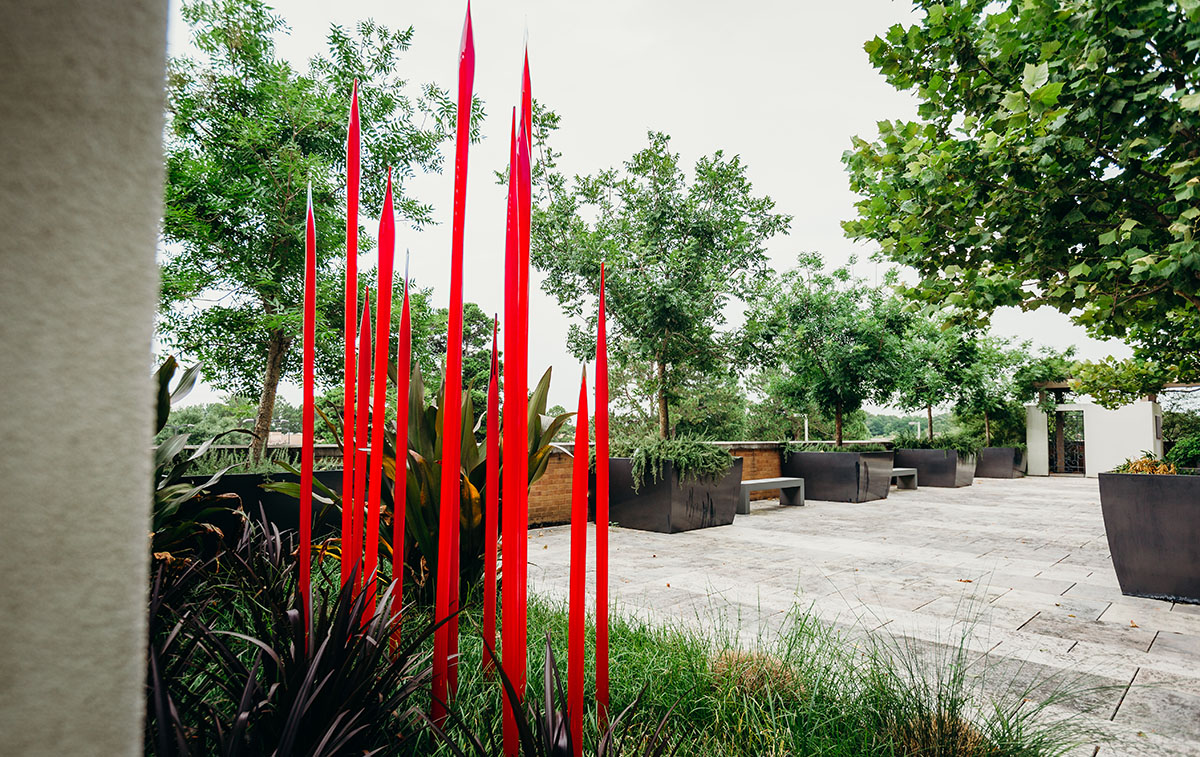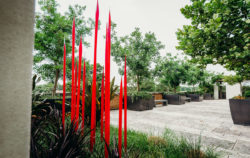Humanities Enhance Medical Education
Creating place and purpose in a new medical school
Published: August 30, 2019
Last Updated: June 1, 2023

Photo by Lucie Monk Carter
Dale Chihuly’s Red Sticks adds a playful, artistic accent to the medical school’s outdoor space.
George Karam had built a reputation for attracting top talent; now he needed to sustain it, not only for his program, but also for the greater Baton Rouge area, since many students set up practices in the community where they train. This was the impetus for Karam to introduce the humanities at the new Medical Education and Innovation Center (MEIC) on the campus of Our Lady of the Lake.
Although numerous medical education programs around the country have infused their curricula with humanist elements, Karam’s is the only one in Louisiana to do so consciously through the new building’s architecture and carefully chosen artworks. The program’s website notes that it offers a “pedagogy that trains residents to diagnose according to possibilities rather than probabilities,” encouraging problem-solving and critical thinking about each patient as an individual instead of giving reflexive answers. This academic humanistic consciousness trains students to become doctors able to “adjust where [they’re] going,” Karam believes. The psychiatry and emergency medicine departments that share the building also benefit from the environment.
With eighteen months’ lead time to build a humanities foundation in the new space, George Karam turned to professionals for help. Carol Gikas, then executive director of the Louisiana Art and Science Museum, advised him to create a sense of place in the new building. “Experiencing a sense of place prepares our senses, minds, and hearts to be engaged,” she told him.
This inspired Karam to create the distinctive sense of place that combines the tenets of medical education with evocations of Louisiana. Pat Bacot, former director of the LSU Museum of Art, helped him collect decorative pieces that included an early nineteenth-century silk embroidery and watercolor depiction of Aesculapius, the Greco-Roman god of medicine, and his serpent-wrapped staff. Works by Louisiana artists Frank Hayden, John Scott, George Dunbar, and others appear throughout the building. In a fourth-floor conference room, Karam has hung a calligraphic rendition of the Hippocratic Oath enshrined in an antique wooden frame. On the large facing wall of the building’s lobby looms a large bronze relief copy by Brad Bourgoyne of Enrique Alferez’s sculpture Louisiana at Work and Play, which was famously embedded over the door of Charity Hospital in New Orleans, the model of purpose-driven medicine in Louisiana for decades.
Historic landscape architect and former LSU professor Suzanne Turner helped design thesecond-floor Teaching Terrace. The open-air space includes a planetree or sycamore similar to the one that shaded Hippocrates when he taught Greek medical students. Wrought-iron railings and trellises reminiscent of New Orleans, as well as seating areas for contemplation, a water feature created from an eighteenth-century sugar kettle, and a commissioned Dale Chihuly red glass “reed” sculpture all add to the ambience. The Chihuly piece, according to Karam, makes a double statement: both artistic, as a work by an internationally renowned sculptor, and playful, since its title is Red Sticks, or Batons Rouges.
The main hallway of the second-floor Innovation Center forms an ellipse: hands-on clinical spaces and individual break-out rooms for medical student and resident instruction lie off the corridor. The hallway’s ceiling-wall junction is decorated at intervals with Art Deco panels reminiscent of Charity Hospital, and the ellipse culminates in a conversation and meeting space called the Reconciliation Room. This circular room paneled in warm-tone woods is centered by a new Art Deco–style table overhung with a 1935 French Art Deco lantern fixture; it is a space designed to foster conversation and consideration among doctors. The ellipse itself is separated from the Teaching Terrace by a glass wall, providing views of both the terrace and the clinical buildings of the Our Lady of the Lake campus beyond.
The new facility brings a more intellectual approach to humanism than was found at the old Earl K. Long hospital, Karam admits, but he is pleased that his vision has generated the enthusiasm he’d hoped for. Medical residents Martin J. Marak and Logan Leblanc both vouch for it. Marak especially responded to the Bourgoyne frieze, which reminds him that, despite long days, extra hours, and endless paperwork, he must remember that “our patients are more than just a name and medical chart . . . they have jobs, hobbies, homes, and loved ones.” For Leblanc, inspiration derives from an inscribed quotation by William Osler, reminding medical students and faculty alike that medicine “is a calling in which your heart will be exercised equally with your head.”
Mary Ann Sternberg is a longtime narrative nonfiction writer and author of four nonfiction books. She specializes in Louisiana history and culture, including the River Road, as well as travel and personal essays. Her work has appeared in a variety of local, regional, and national newspapers and magazines including Preservation, AARP Magazine, and the Dallas Morning News. She lives in Baton Rouge.
